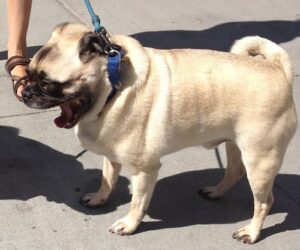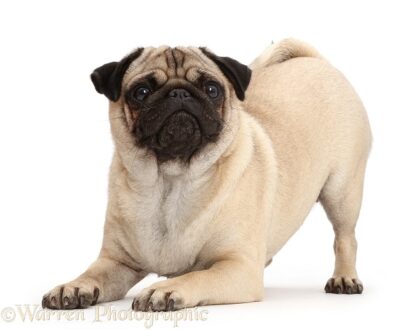Pugs are a popular breed of dog known for their wrinkled faces, compact size, and cheerful personalities. These adorable dogs have become a staple in popular culture, appearing in movies, commercials, and even as Internet memes. But beyond their cute appearance, what is the Pug temperament? This article will dive into the Pug breed to better understand their behavior, needs, and overall temperament.
Pugs are known for their friendly and playful temperament. They are friendly and affectionate with their owners and are good with children and other pets. Pugs are also known for their playful and comical personality and tend to be clownish and make their owners laugh.
They are generally easy-going and adaptable, making them a popular choice for apartment living. However, they tend to become lazy and overweight if not given enough exercise, so keeping them active is essential.
Pugs are also known for their intelligence and trainability, which makes them an excellent choice for first-time dog owners. They are also typically good watchdogs, although their small size can limit their effectiveness. Pugs have a strong desire to please their owners and are eager to learn, but they can also be stubborn sometimes.
It’s important to remember that, like all breeds, Pugs have individual personalities and temperaments that can vary greatly. Factors such as socialization, training, and genetics can all shape a Pug’s personality.
Pug temperament

Pugs are known for their playful, affectionate, and friendly temperament. They are a popular breed for families due to their adaptability and tendency to form close bonds with their owners. They are also known for their even-tempered and lively personalities. However, they can be stubborn and may require patience and consistency in training.
Pugs are also known for being good with children and other pets. They are lively and energetic yet can be lazy sometimes and love to lounge and relax. They enjoy playing but also love cuddling with their owners.
Moreover, Pugs tend to be clingy and crave attention, and they are known for following their owners around. They have cheerful and charming personalities, making them a popular choice for families and individuals. However, they can also be prone to certain health issues due to their flat faces, so proper care and veterinary attention are necessary.
Are Pugs good with children?
Pugs are generally good with children. They are playful, affectionate, and friendly, which makes them a good choice for families with kids. Pugs are known for their even-tempered and friendly personalities and tend to form close bonds with their owners, including children.
However, as with all breeds, it is essential to supervise interactions between dogs and young children to ensure their safety.
It’s important to remember that Pugs are a small breed with short snouts, which means they can be prone to specific health issues and may be more fragile than other breeds. Children should be taught to handle them gently and not to roughhouse or play too roughly with them.
Additionally, Pugs may become overwhelmed or stressed by excessive noise or commotion, so providing them with a calm and secure environment is essential. Pugs can be excellent companions for children and make great additions to families.
Are Pugs easy to train?

Pugs can be challenging to train due to their stubborn and independent nature. However, they are also highly intelligent and can be prepared with patience, consistency, and positive reinforcement techniques.
Moreover, Pugs tend to respond best to training in short, structured, fun, and engaging sessions. They can also be prone to boredom, so it’s essential to keep training sessions varied and interesting. Consistency is key when training a Pug, as they may try to take advantage of their owners if they sense any inconsistency or weakness.
It’s also important to remember that Pugs crave attention and affection, so using treats, praise, and positive reinforcement can be highly effective when training them.
Are Pugs good with other pets?
Pugs can be good with other pets, especially if they are socialized properly from a young age. Pugs are generally friendly and pleasant and tend to get along well with other animals, including cats and dogs.
However, as with any breed, it’s important to supervise their interactions with other pets, especially during playtime, to ensure that everyone is safe and happy. Socialization can also help prevent any potential aggression or territorial behavior from developing.
Introducing a Pug to a new pet is best to do so gradually and in a controlled environment to help ensure a positive outcome.
It’s important to remember that each Pug and each pet has its unique personality and individual needs, and not all Pugs will get along with all other pets. Some Pugs may have a strong prey drive and chase small animals, while others may be more laid back and tolerate other pets well.
Some Pugs may be dominant, while others may be more submissive. Socializing a Pug with other animals and supervising their interactions can help them coexist peacefully and form positive relationships.
Providing each pet with plenty of individual attention, exercise, and mental stimulation can also help reduce competition for resources and prevent any conflicts from arising. Pugs can be good with other pets with proper care and attention.
Are Pugs good apartment dogs?

Pugs are good apartment dogs as they are a small breed that does not require a lot of space. They are adaptable and can live comfortably in various living arrangements, including small apartments and homes with limited outdoor space.
They are also relatively low-energy dogs, although they do enjoy playtime and exercise and can adapt well to city living. Pugs can also be relatively low-maintenance in terms of grooming and exercise needs, making them a good choice for apartment dwellers with limited time or resources for care.
However, it’s vital to provide Pugs with plenty of mental stimulation and socialization to prevent boredom and ensure their overall well-being.
Are Pugs good watchdogs?
Pugs are not typically considered to be good watchdogs. While they are friendly and pleasant, they are not known for their guarding instincts. Pugs generally are more interested in seeking attention and affection from their owners than in guarding their homes.
Moreover, they may bark at unfamiliar sounds or people, but this is usually done more out of curiosity than any protective instinct.
In general, Pugs are better suited to being loving and affectionate companions than they are to be watchdogs. If you’re looking for a dog to help protect your home, consider a different breed known for its guarding instincts.
Are Pugs good with first-time dog owners?

Pugs can be good with first-time dog owners, as they are known for their affectionate and friendly temperament. They are also relatively low-maintenance in terms of grooming and exercise, making them a good choice for people needing more experience caring for dogs.
However, as with any breed, it’s essential to be prepared for the responsibilities of dog ownership and to educate oneself on the breed’s specific needs and personality. Pugs can be stubborn and may require patience and consistency in training, so first-time dog owners should be prepared to invest time and effort into training and socializing their dogs.
Additionally, Pugs can be prone to specific health issues due to their flat faces, so first-time dog owners should be prepared to provide proper care and veterinary attention. Pugs can be good with first-time dog owners with appropriate education and preparation.
Do Pugs shed a lot?
Pugs are a moderate shedding breed and do shed regularly throughout the year. Their smooth, short coats require minimal grooming, but they shed hair that can be noticeable on clothing and furniture. Regular brushing can help minimize shedding and keep their coats looking healthy and shiny.
However, ensure to bathe and groom Pugs regularly to remove loose hair and prevent matting. Some Pugs may shed more heavily during seasonal changes, which can manage with regular grooming and brushing.
In general, Pugs are an excellent choice for people who are looking for a small, affectionate companion that doesn’t shed excessively. Still, they shed a moderate amount and may require some grooming to maintain their coats.
Are Pugs good for families?

Pugs can be good for families. They are known for their affectionate and sociable temperament and are generally friendly with children and adults alike. Pugs are also small, making them a good choice for families with limited space.
They are generally low-energy dogs, although they enjoy playtime and exercise and can adapt well to family life. Pugs can be a good choice for families with children, as they are generally good-natured and tolerant and tend to be patient and gentle with children.
However, as with any breed, it’s important to supervise interactions between dogs and children to ensure everyone’s safety. In general, Pugs can be a good choice for families who are looking for a small, affectionate, and low-maintenance companion.
Are Pugs good for seniors?
Pugs can be a good choice for seniors as they are a small, low-energy breed that doesn’t require much exercise. They are generally affectionate and good-natured, making them good companions for seniors who may be looking for a dog to provide them with affection and companionship.
Additionally, Pugs are relatively low maintenance in terms of grooming and exercise needs, making them a good choice for seniors with limited mobility or time for dog care.
However, it’s essential to consider that Pugs can be prone to specific health issues due to their flat faces, and seniors should be prepared to provide proper care and veterinary attention for their dogs. In general, Pugs can be a good choice for seniors who are looking for a small, affectionate, and low-maintenance companion.
Are Pugs good for people with allergies?

Some people with allergies may find Pugs a good choice, as they are a low-shedding breed with a smooth, short coat. However, no breed is 100% hypoallergenic, and some people with allergies may still experience symptoms when around Pugs. This is because allergens are found in pet hair, dander (dead skin cells), saliva, and urine.
In addition, People with allergies should spend time around Pugs before adopting one to see if they react. Regular grooming and bathing can minimize the number of allergens in the environment. Using air purifiers and vacuum cleaners with HEPA filters can also help reduce allergens in the home.
Pugs may be a good choice for some people with allergies, but it’s crucial for individuals with allergies to spend time around the breed and take proper precautions to manage their symptoms.
Are Pugs good for people with mobility issues?
Pugs are a good choice for people with mobility issues, as they are a small breed that doesn’t require much exercise. They are also generally low-energy and adapt well to an apartment or indoor living, making them a good choice for people with limited mobility or space.
However, it’s essential to remember that Pugs can be prone to specific health issues due to their flat faces, which can impact their mobility. People with mobility issues should consider the breed’s specific health needs and be prepared to provide proper care and veterinary attention for their dog.
Additionally, some Pugs may become overweight if they do not get enough exercise, which can also impact their mobility. Hence, people with mobility issues need to ensure their dog gets regular exercise in a way that is safe and comfortable for them.
Pugs can be a good choice for people with mobility issues who are looking for a small, low-energy companion that doesn’t require much exercise.
Are Pugs good for people with busy lifestyles?

Pugs can be a good choice for people with busy lifestyles, as they are a small breed that doesn’t require much exercise. They are also generally low maintenance in terms of grooming needs, making them a good choice for people who may need more time for dog care.
Moreover, Pugs are adaptable and can do well in various living situations, including apartment or indoor living, making them a good choice for people on the go. However, it’s important to remember that Pugs need socialization and mental stimulation, and they should not be left alone for extended periods.
People with busy lifestyles should ensure they have the time to provide their dogs with proper care, including exercise, grooming, and affection. Pugs can be a good choice for people with busy lifestyles looking for a small, low-maintenance companion that doesn’t require much exercise.
Are Pugs good for people who travel often?
Pugs may not be the best choice for people who often travel, as they are a breed that bonds closely with their owners and can become anxious or stressed when separated from them.
Additionally, Pugs can be prone to certain health issues due to their flat faces, making travel and boarding more challenging for the dog and owner. People who travel often should consider the breed’s specific health and separation anxiety needs and be prepared to provide proper care and veterinary attention for their dog, even while away from home.
Pugs may not be the best choice for people who travel often and want a dog that can easily adapt to different environments and situations.
Are Pugs prone to health issues?

Pugs can be prone to certain health issues due to their unique physical characteristics, including short snouts, large eyes, and wrinkles. Some common health issues in Pugs include:
- Breathing difficulties: Pugs have short snouts, which can cause breathing difficulties and make them more susceptible to heatstroke.
- Eye problems: Pugs have large eyes that are more prone to injury and eye infections.
- Skin problems: Pugs’ wrinkles can collect moisture, dirt, and bacteria, leading to skin infections.
- Overweight: Pugs are prone to becoming overweight, leading to other health problems, such as joint problems and diabetes.
- Hemivertebrae: This is a congenital spinal condition that can cause a malformation of the vertebrae and result in spinal problems.
- Patellar luxation: This knee joint problem can cause the kneecap to slip out of place, causing pain and lameness.
It’s crucial for Pug owners to be aware of these health issues and to provide regular veterinary care, including regular check-ups, vaccinations, and necessary treatments, to ensure their dog stays healthy. In general, Pugs can be prone to specific health issues, but with proper care and veterinary attention, they can live happy and healthy lives.
Conclusion
Pug temperament in conclusion, the Pug is a lovable and affectionate breed that is known for its distinctive appearance and charming personality. Pugs are well-suited for families and individuals looking for a small, low-energy companion that is easy to care for and adapts well to an apartment or indoor living.
However, it’s important to remember that Pugs can be prone to certain health issues, such as breathing and skin problems. They can also become anxious when separated from their owners. With proper care and veterinary attention, Pugs can live happy and healthy lives and make excellent companions for those looking for loyal and affectionate friends.


